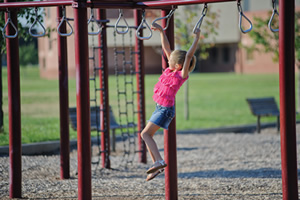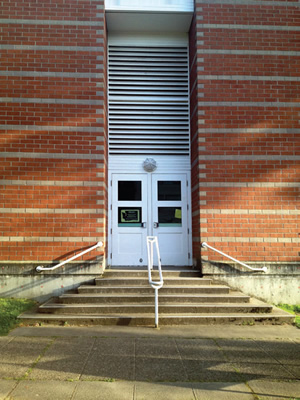Blended School Security
- By Michael Fickes
- 06/01/15

PHOTO © BRENDA STAPLES PHOTOGRAPHY
School districts often spend security budgets in ways that don’t really enhance security or protect students. “I see many K-12 schools and districts spending money on security — without achieving security or protecting students,” says Charlie Howell, a principal with Division 28 Consulting, LLC, a San Antonio-based school security consulting firm.
“One school planned to install 200 cameras and send the video feed to the police department dispatch center,” Howell says. “But at the dispatch center, one police officer will have to watch those 200 cameras and a couple hundred more cameras from other security installations. How would this plan protect students?”
In almost all security programs, cameras are forensic tools, continues Howell. In other words, cameras are used to investigate events after they have occurred.
Well-defined specific tasks are exceptions to this rule. For instance, a principal might place a camera at each entrance and assign one person to secure those entrances. The responsibilities might include monitoring the cameras, screening visitors visually and over an intercom, dispatching a receptionist from the office to let the person and escorting him or her to the office for a visitor’s pass.
Howell advises building a security program by first carrying out a security assessment that identifies the risks and vulnerabilities a school is subject to.
A security program addresses those risks and vulnerabilities, eliminating them when possible and mitigating those that can’t be eliminated.
Finally, and perhaps most importantly, Howell recommends blending the security program into the day-to-day operation of the school.
“If you install a security program that is perpendicular to a schools operation — to coin a phrase — the teachers, staff and students will break the program because it will be too inconvenient,” Howell says. “One of my roles is to blend security into operations. When that is done right, no one will notice the security elements when following a normal operating day.
“When someone moves out of the normal operational path, he or she should feel the security program.”
Security 101
Howell defines security with four words: deter, detect, delay and respond — in that order.
Deterring means security that makes a would-be attacker decide not to try. Deterrence doesn’t always work. Suppose someone breaks through the access-controlled door. When that happens, and alarm sensor detects it and sets off an alarm, which alerts security.
Detection sets off a call to people capable of mounting a response — adults working in the school or security officers in some cases and police officers in more serious cases.
As the response gets organized, the security program must delay the intruder, perhaps with hall gates and internal locked and access controlled doors.
Ultimately, the responders arrive and put an end to the crisis.
People manage these basics, sometimes with the support of physical security technology.

PHOTO BY JOE WOLF
Exit Points. Elementary schools need more access control — both to keep unauthorized people out and to delay unauthorized people who are trying get in. An important thing to consider when designing a school’s access control system is the day-to-day operational flow of students, faculty, staff and visitors into and through the school.
Access control in elementary schools
“I’ve seen many elementary schools with a card reader on the door to the playground,” Howell says. “But then there are no readers on the side doors to the school, and those doors are unlocked.”
Before installing card readers, Howell advises analyzing the role of an access control system in protecting students. He notes that elementary schools need a comprehensive access control system, one that controls every door. “An active shooter in an elementary school will lead to the worst possible disaster,” he says. “The young children won’t be able to get away and they will be slaughtered.
“So conceptually, elementary schools need more access control — both to keep unauthorized people out and to delay unauthorized people who eventually get in.”
Howell starts thinking about the design of an elementary school’s access control system by analyzing the day-to-day operational flow of students, faculty, staff and visitors into and through the school.
Where are the entry points in the morning when everyone is entering the school? Where are the exit points at the close of the school day?
Where is the entry point for visitors and parents during the instructional day?
What is the flow of students and teachers to the playground at recess?
If there are portables, what is the pathway and doors out of the school and into the portable area?
Howell goes over his operational flow analysis with administrators and asks if he has missed anything.
“Using the flow analysis, I can identify appropriate doors for readers,” he says. “Typically, that would include exterior doors used regularly. Rarely used exterior doors can be locked but don’t need readers.
“In the morning, we would unlock the exterior doors used by students, faculty and staff. When everyone has arrived, we lock down for the day.”
Howell also consults with teachers about locking down their classrooms. The discussion starts at the classroom door on the subject of locking the door in an emergency. “If they have to reach outside to lock the door, they won’t want to,” Howell says. “Key locks don’t work well for everyone. Those that are scared will be shaking and unable to get the key into the keyhole.
“There are two answers: a pushbutton on the knob or a removable magnetic strip on the door frame over the strike hole. They simply push the button or remove the strip.”
Security professionals carry out additional analyses to program other physical security technologies and measures including radios for communications, video cameras, alarms, the composition and layout of a security station as well as barriers, lighting and landscaping.
Learn to analyze your security needs, and you will begin to spend your security dollars in ways that enhance security and protect students.
This article originally appeared in the issue of .